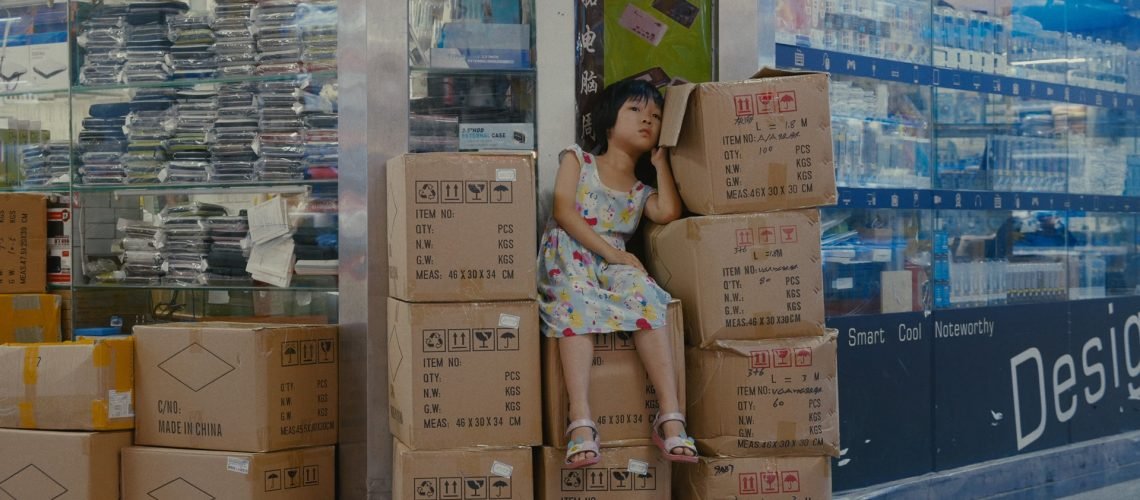The One Who Runs Away Is The Ghost sees an electronics market in Shenzen through two young sisters’ eyes – a world of ghosts and monsters. It was the perfect opportunity for the equally fantastic Imaginarium of Hainbach’s electronic music compositions. He talks to us about his process and the connection between machines, memory, and the curiosity of children (including his younger self).
Qinyuan Lei’s vision of Shenzen through markets, vending machines, and other electronics premiered back in 2021, but this month saw a UK premiere at MINT, the first female-organized Chinese film festival in the country. And now in case you don’t have a theatrical screening near you, you can her movie, too – it’s now available as video-on-demand on Vimeo, alongside Hainbach’s soundtrack release (digital and, of course, cassette tape) on Bandcamp.

Mandarin Chinese with English Subtitles.
Haohao and Zhouzhou, two sisters aged five and eight, spend most of their days
at an electronics market in Shenzhen. A year earlier, as new immigrants to the city,
their parents opened a shop on the market’s ninth floor.
The girls’ gaze turns the soulless world of electronics into a universe full of monsters
and ghost stories that make life more magical.
Watch the film on Vimeo video-on-demand (rent or buy)
In the music, we get machines’ spiritual essence through a different filter – not industrial rhythms, like techno or Ravel’s Bolero (really), but meditative, transformative states, like pools of water.
It’s not just that Hainbach exploits the drift of tape or gauzy layers of analog equipment, but the way in which that makes these machines take on something organic and dreamlike. These are machines as holding endless potential, not just
I wanted to talk to Stefan more about that work. He responded via email here in Berlin.
CDM: It seems a natural fit, in that your own music itself explores the fantastic world of machines. We could also imagine how machines are inhabited by some spirit. How did you think about the relationship of your machines to the electronic worlds of the film?
Hainbach: When writing for film, theater, or any other media, I try to help in the world building. For Schock, a hard-boiled mafia thriller that comes to cinemas this week, I employed synths that could have been used by Goblin in their Giallo soundtracks. For this film, I wanted to shape a contrast between the electronic world and the playfulness of the kids. I used toy pianos and my by now ancient OP-1 and paired that with the wall of test equipment and instruments I had made from my Landfill Totems installation.
It’s always been interesting to me that some film composers are also film editors, that there’s overlap. What was the process of scoring like for you; how did you go about mapping these very slow-shifting phrases in the electronics to the image on the screen?
The music in this movie serves a rather poetic function, so I had no need for hard cuts. Thanks to my experience with tape, I now have a “half-speed” button in my head that enables me to go glacial even without tape. That really helped when going between scenes, and often I would let notes linger longer than my YouTube editing brain would ever do.

Had you had any personal experience with the shooting locations?
I sadly have no experience of Shenzen – I only got to explore through the movie. For an upcoming film with Fatih Akin I will accompany shooting and record on scene. But that is not a trip around the world, just to the North Sea.
I think we don’t often talk a lot about parenting in music – maybe the music industry tends to live in its own sort of endless teen fantasy of itself. But did you see this film through those eyes as a parent? Or partly through the eyes of your daughters, too?
Oh there is a life before and after being a parent, especially as a musician. It has turned me into a very effective “9 to 5” musician for example, instead of doing the rather unhealthy “until exhaustion” workflow. I definitely look at the kids in the film differently, especially as I have two daughters myself who were about the same age. Their explorations resonated with what I see with my kids daily.
Let’s talk a bit about the machines – what are we hearing on this record? How much were you layering versus things happening in one take? I hear a contrast between something clearer on the surface, and then some fuzzier/more degraded tape elements. It’s almost as though you’re using tape deterioration the way conventionally, some folks have used reverb, putting things into the background, right?
If you put things on a lo-fi tape machine such as a dictaphone or a worn reel-to-reel loop, they become more human. They sound like a memory. It is rare that memories shine bright; often they are fuzzy, distorted, and when you try to remember more closely, they fall apart. I explored that in my scoring with a drama that played at theatre Bonn, about the memories of a dementia-addled spy. Many of these recordings ended up on Ambient Piano Works, my first album on Seil. In this film, I use it to make the sound world more “kind” and human. It would be very easy to have synths sound absolutely dystopian else, when paired with the technological images.

If you put things on a lo-fi tape machine such as a dictaphone or a worn reel-to-reel loop, they become more human. They sound like a memory.
I know you’ve also become more involved in collaboration with software development. Did you work with any of those tools or think about inventing solutions to what the film needed compositionally?
I used Wires, a lo-fi wire recorder I made with AudioThing, to shape synths on a bunch of tracks here. For variations on themes, I employed a technique I learned when writing for orchestra. There, I would compose a piece on a modular synth and then run it through the audio-to-MIDI function in Ableton Live. That would create a huge mess of notes, all sounding completely off. But I could carve the piece from that mess, pick out different lines, and distribute them across different instruments — a very inspiring process. Instead of an orchestra, I used the Landfill Totems library instrument I made with Spitfire Audio. Since that was created from statues I made from obsolete test equipment, it fits beautifully in the sonic space of the film.

I wonder if the film itself gave you any different insight into machines and fantasy or what did you take away? And you are releasing the soundtrack separately, so does that mean you hope that the score will also have a life on its own?
I always loved machinery. I took apart the clocks and watches in my parents’ home as a kid. I would go to scrap yards and explore. This movie resonated immediately because of that. The main reason why I think that the soundtrack can stand on its own is that Felix of Moserfilm curated it. He previously helped me put Home Stories and Core Memory together; he has got a fantastic ear on how to make a coherent record.
I always loved machinery. I took apart the clocks and watches in my parents’ home as a kid. I would go to scrap yards and explore. This movie resonated immediately because of that.
You’ve now built up a pretty broad library on Seil Records alone. I know for a lot of artists, the different work we do – the day job, the professional work, the journalist or producer side, the technologist or composer – can all pull at one another. Was there some effort to harmonize those things, even just managing the amount of hours in the day?
Oh, that is constant juggling. I am lucky that my wife helps me with administration, else I would not be able to do half as much. The main thing I really listen to now is my health – that is the first thing to suffer in what could essentially be an eternal crunchtime. First my wrists go, then my sleep, then my mood shifts because of the work-pain feedback loop. I love my work to a fault; I get lost in it. So I have built a strict work schedule (9-13 creative, 14:30-16:30 admin, 21-23 creative), and I accept that these hours are all I have. Otherwise, I’m stealing from my future me and my family. I do break these occasionally when I have someone like Sam (Look Mum No Computer) come by and we just go mad. But that is marked as an exception in the calendar.
More on the film:
More on Hainbach:
And that time I got to jam with him – we should do this again, actually (not necessarily with MeeBlip):




